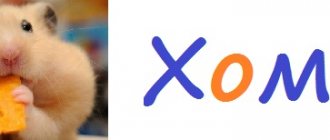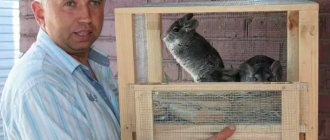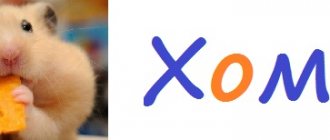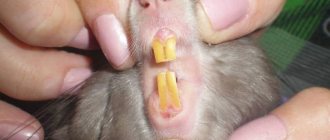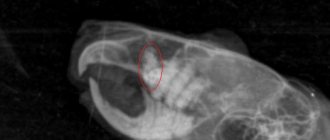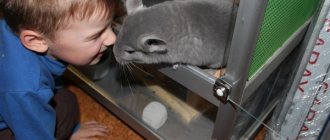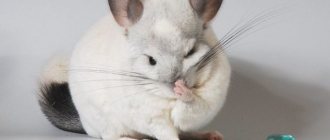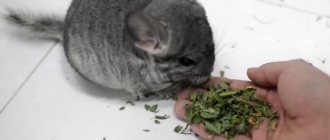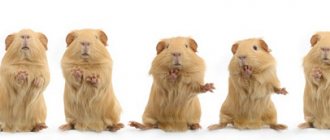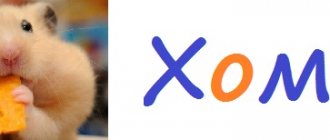- home
- Chinchilla
- Health
03/25/2019 A chinchilla is a rodent, which is why a chinchilla’s teeth grow throughout its life. They have 20 teeth on each jaw, although at first glance it seems that there are only two pairs of them. In addition to the central incisors, the animal’s oral cavity contains cheek teeth. Buccal – molars and premolars, designed for chewing food. Chinchillas do not have fangs.
Dental problems have a negative impact on your pet's health. In addition to refusal to eat and painful sensations during life, the danger of pathologies is that advanced cases can lead to the death of the animal. Therefore, being attentive to what is happening in the pet’s oral cavity is the duty of a good owner.
How many teeth does a chinchilla have, features of their structure
The main feature of chinchilla teeth is continuous growth throughout life and the absence of enamel on the back wall of the tooth, which is why various problems can sometimes arise.
A chinchilla has 20 teeth in total.
Molars have a fairly wide and jagged surface, which is used for chewing food; their roots are located at a deep level, inside the jaw. The length of the tooth is almost 1.5 cm, including the root system and crown. A newborn chinchilla has 4 incisors and 8 cheek teeth. Compared to other animals, chinchillas do not have fangs. The place where they should be located is empty, and is called a diastema.
The normal, healthy shade of the front incisors is carrot-yellow. The back of the tooth is not covered with enamel, which is why they can be ground down without any problems.
By moving the lower lip of a rodent, you can see how the teeth are located and arranged:
- two on top and two on the bottom of the incisor - their length can be from 0.5 to 1.3 cm.
There are 16 more teeth located deep in the oral cavity:
- premolars in the amount of 4 pieces, located symmetrically, two on each edge on both jaws;
- There are 12 molars, they are located in threes, behind the cheeks on both jaws.
Mashusha
The structure of teeth in chinchillas. Malocclusion (hooks).
Teeth play one of the most important roles in life. With the help of teeth, animals capture, hold and chew food, hunt for prey, defend themselves, build their homes, and much more. In order to learn about some dental diseases, you must first consider their structure.
Let's look at the structure of a tooth using a human example:
It is easy to write the dental set in the form of a formula. The formula is compiled only for one side of the upper and lower jaws (to calculate the total number of teeth, you must multiply by 2). Designations: I - incisors, C - canines, P - premolars and M - molars, upper and lower jaws - numerator and denominator of the fraction.
Chinchilla teeth set:
The structure of the chewing surface and the number of molars are important characteristics that are used to divide rodents into different families, subfamilies and genera, as well as in the diagnosis of species.
X-ray. Spikes on the upper molars, the lower first incisor is angled and directed forward.
Inspection of bedrock swells is carried out using an otoscope. If hooks are found, they are trimmed. If the chinchilla is calm, then the entire procedure is carried out without the use of general anesthesia. Unfortunately, the disease is not curable. Chinchillas with malocclusion are removed from breeding due to the fact that this disease can be transmitted hereditarily. You can only prolong the life of your pet by feeding it artificially, constantly taking it to the veterinarian for examination and carrying out procedures to remove hooks. But unfortunately, the result is the same. for some in a month, for others in a few years.
There have been cases of plaque and tartar detection. Plaque
- biofilm located throughout the oral cavity.
It consists of mucus and more than 300 types of bacteria. Tartar
is an acquired formation at the site of dental plaque, which occurs due to mineralization (a mixture of phosphate and calcium carbonate with a small content of organic substances and various microorganisms). Bacteria, together with pieces of stuck food, form a soft, light-colored plaque. Then calcareous salts contained in saliva settle on the plaque, and it acquires a dense consistency and becomes tartar. Over time, tartar darkens, grows and increases in volume. As a rule, tartar forms on the front and back surfaces of the tooth, i.e. places with weak mechanical load. Inflammation of the gums and drooling occurs. The stone is removed by a veterinarian and anti-inflammatory ointments are prescribed. It is extremely rare.
Source
Dental pathologies
It is very important to monitor the health of the animal’s oral cavity, in particular its teeth. Otherwise, this may lead to the development of various diseases that have negative consequences and can be life-threatening for the rodent. Ignoring dental pathologies in a chinchilla can even provoke the death of the animal.
With improper or inadequate nutrition, as well as for a number of other reasons, various dental pathologies can occur. Dental diseases can have an extremely negative impact on the general condition of the rodent - they may refuse to eat and, because of this, lose weight. If the disease is ignored, the animal may die, so it is advisable to contact a veterinarian if problems arise.
A fairly common problem is the need to trim teeth; it is not recommended to carry out this procedure at home; it is better to do it in a hospital setting.
The doctor carries out this manipulation using painkillers; teeth grinding does not take much time and does not cause severe discomfort to the animal.
Dental pathologies have a number of signs that should alert you and cause you to contact a veterinarian:
- the animal becomes selective in food. Scattering and sorting through the offered food, the rodent tries to choose only soft food;
- the animal may completely refuse food and hay;
- wet hair on the front legs, around the mouth, as well as a noticeable increase in saliva production should alert you;
- swelling of the jaws or gums may be observed;
- loose stools or its complete absence may also indicate dental problems;
- the incisors have become too long and are sticking out;
- Fistulas formed on the animal’s cheeks.
Most diseases proceed almost unnoticed in the initial stages, so if such symptoms appear, this indicates that the disease is advanced.
Along with dental pathologies, as a result, problems and malfunctions in the gastrointestinal tract and liver begin to develop. The animal may begin to rapidly lose weight, which can be fatal.
Another common pathology is infections. Chinchilla teeth wear out quickly because... lack enamel, so they are vulnerable to various types of infections. It is important to know that the healthy color of teeth in a rodent is yellow or orange, and white teeth may indicate a lack of calcium.
Causes of dental pathologies
There are several reasons why dental problems may occur in these rodents:
- Genetic factor.
- Congenital pathologies.
- Unbalanced diet.
- Lack of solid food.
- Injuries as a result of which the teeth were displaced and an incorrect bite was formed, and therefore there is no proper natural grinding of the teeth.
- Diseases affecting appetite.
- Insufficient amounts of minerals and trace elements - especially in females during pregnancy and lactation.
Unfortunately, problems caused by genetics have not been studied to date; experienced breeders do not allow such individuals to reproduce.
Types of dental pathologies in chinchillas
The most common dental pathologies in chinchillas, which differ in symptoms, have been identified:
- Malocclusion.
- Crown regrowth.
- Ingrown tooth roots.
- Tooth loss.
It is very difficult to determine a disease without the necessary knowledge, and it is advisable to entrust this to a specialist without self-medicating. If you notice signs of dental pathologies, you should immediately consult a veterinarian.
What is malocclusion?
b] Malocclusion refers to malocclusion.
Throughout their lives, rodents grow chewing teeth and incisors. Naturally, the animal wears them off as it eats. But under certain circumstances, the grinding plane of the teeth may be disrupted. As a result, the teeth do not wear down properly, which leads to the formation of thin, sharp edges that injure the mucous membranes of the oral cavity and tongue. The main cause of the disease is improper maintenance of the animal (mineral imbalance, lack of items in the cage for grinding teeth, too soft food) or genetic problems.
Chinchillas have 20 teeth (4 incisors and 16 molars). When the teeth do not fit together properly, a chinchilla's bite occurs. As a result, some molars stop grinding down correctly and begin to grow in different directions, forming hooks. These hooks injure the inside of the cheeks, gums and tongue, leading to pain and infection.
You can check the correct growth of the incisors yourself by slightly pulling the chinchilla's mouth up and down. Molars cannot be checked at home. This requires special tools and an experienced veterinarian. You will likely need to take an x-ray to find the source of the problem.
Signs of hook regrowth in a chinchilla will be: weight loss, loss of appetite (or quite the opposite - the chinchilla will more often sit by the food bowl and try to eat at least something). The animal may often rub its mouth with its paws and show nervousness. Drooling, bad breath, and the formation of hollows on the back due to malnutrition are the main signs of a developing disease. It is necessary to consult a doctor as soon as possible.
The bite begins to disturb, but there are several reasons: - heredity; - malocclusion due to improper diet; - loss of one or more teeth;
To identify the problem in the early stages, you need to monitor your pet's eating habits. A symptom of an incorrect bite manifests itself as follows: - the animal constantly rubs its muzzle with its paw; - the mouth does not naturally pull while eating (as during vomiting); - bites and throws food; - avoids hard food, even while remaining cheerful and active - most likely this is the beginning of the disease. Subsequently, if you do not pay attention to this in time, saliva begins to flow from your mouth, the more abundantly it continues. The chinchilla cannot eat normally and even just drinking water gives her discomfort.
Therefore, the effect in the future depends on timely initiation of treatment for malocclusion in chinchips. The sooner measures are taken, the greater the chance of restoring the bite. Unfortunately, heredity cannot be cured.
Regarding heredity, the issue remains controversial. Even a specialist in Moscow on dental problems, M. Alshenetsky, at one time said that heredity in chinchillas can manifest itself up to 3 years of age. then he began to doubt himself, citing that the opinions of leading experts differed.
Source
Malocclusion
Malocclusion develops due to malocclusion, that is, improper closing of the jaws. Insufficient grinding of growing teeth causes the formation of hooks.
This pathology develops for the following reasons:
- unbalanced diet;
- lack of essential minerals;
- autoimmune diseases;
- injuries to teeth or jaws;
- genetic factor.
Malocclusion has its own characteristic symptoms - the rodent refuses to eat food, which is why it begins to rapidly lose weight. The animal eats reluctantly, having first sorted the food in its paws for a long time, and eats only the smallest and softest grains. Further, there is excessive separation of tears and movements reminiscent of gagging. When the form is advanced, the animal begins to salivate heavily, stomatitis (a disease of the oral cavity in which painful ulcers form) appears, and the stool becomes soft or liquid. The rodent's tongue is injured by the sharp edges of overgrown teeth, resulting in bleeding, painful wounds in the mouth. If you do not contact a specialist in time, the animal dies.
If the disease was detected in the later stages, the animal will most likely need to be helped in eating after teeth trimming. To nurse your pet, feed is ground and administered using a syringe. Thanks to this, the animal understands that there is no pain and begins to eat on its own.
Prevention of malocclusion
Like most other diseases, malocclusion is easier to prevent than to treat. To avoid the development of this disease, experts advise:
- Provide your pet with proper nutrition, which should include granulated food, mineral stones, and branches.
- Hay must be included in the diet. It is the main source of fiber and helps to wear down molars.
Granulated food is great for grinding teeth , but it should not become a substitute for natural food. It is best to take branches from the following trees:
- ash;
- maple;
- birch;
- elm;
- apple or pear tree;
- blackberries, etc.
In addition to mineral stone, you can purchase wooden toys for rodents. As a preventive measure, experts recommend showing the animal to a veterinarian at least once a year.
Crown regrowth
The second common dental pathology is crown regrowth.
When eating solid food or special objects, the rodent's teeth are ground down. If the animal does not have this opportunity, then the crowns of the teeth grow back, which causes other problems, such as malocclusion, excessive salivation, and subsequent refusal to eat.
Ingrown tooth roots
A fairly common pathology is ingrowth or elongation of roots; this problem can develop equally on both jaws. If the ingrowth occurs in the upper jaw, the sinuses and eyes may suffer. If the problem began in the lower jaw, then swelling of the entire jaw is noted.
This disease has a number of characteristic signs:
- painful sensations;
- loss of appetite;
- weight loss;
- development of conjunctivitis and nasal discharge;
- abscess on the face.
This pathology is considered very rare and can only be detected using x-rays. This disease has no cure.
Respiratory tract
Runny nose
The off-season often provokes not only nasal catarrh, but also various colds. It is not difficult to recognize a runny nose. The animal develops white or yellowish mucus in the corners of its eyes, and its nose is wet and snotty. The general condition of the animal is drowsy. Boric acid (2% solution) will help cure the disease.
It is important for them to wash the chinchilla's eyes. Also replace the solution with a strong infusion of tea
Bronchopneumonia
If the rodent begins to cough, and its breathing quickens and is accompanied by hoarseness, then it is important to be wary. These are signs that your cold is getting worse
In this case, you should contact a veterinarian, who will prescribe an expectorant and Biomycin. The course of treatment will last about a week.
Pneumonia
This disease occurs more often in newborn fur babies and in the autumn-winter period.
Pneumonia is a consequence of the animal’s incomplete recovery from a cold. The disease is accompanied by an increase in the animal's normal body temperature, heavy breathing with noise and purulent discharge from the nose.
Treatment occurs exclusively with the participation of a veterinarian, who will prescribe antibiotics.
Hyperemia of the lungs
A common cause of this disease is improper maintenance. The animal inhales hot air or toxic substances. Signs of the disease include choking and rapid heartbeat, reddish foam from the nose and a cough with wheezing.
It is important to start treatment by changing the room in which the pet is kept. The animal should be moved to a room whose air temperature is about 18ºC, with good ventilation
Since the true cause of hyperemia is extremely difficult to determine, it is important to find out the treatment regimen from your veterinarian.
Tooth loss
The peculiar structure of chinchillas' teeth can sometimes cause negative consequences. The fact is that under the root system there is a “reserve” or “subgingival” part, sometimes it can grow in, causing problems with the eyes or sinuses.
Characteristic symptoms of this pathology:
- painful sensations;
- loss of appetite;
- weight loss;
- development of conjunctivitis and rhinitis;
- formations on the jaw, abscesses.
If your pet has lost a tooth, you should treat the oral cavity with an antiseptic solution and show the animal to a doctor. Tooth loss may indicate the development of pathology, stomatitis or injuries.
Features and methods of treatment
If you discover symptoms of dental pathologies in your pet, you should not ignore and let everything take its course: the sooner you contact a specialist, the easier the treatment will be.
Before starting treatment, the specialist must carry out diagnostics and, based on the results, make a diagnosis and prescribe the necessary treatment.
Diagnostics includes:
- Examination using an otoscope under anesthesia.
- X-ray of teeth.
- CT (computed tomography).
As with humans, all animal surgeries are performed in a specially equipped room. If a rodent needs its teeth ground down, the animal is restrained so as not to cause injury. The procedure is carried out by mechanical grinding.
Tooth extraction is also performed in a special room using anesthesia.
After the manipulations, the animal will need care during recovery in the postoperative period.
Care involves:
- treatment of the oral cavity;
- anesthesia;
- feeding the rodent in the first days after surgery;
- inspection by a specialist.
An examination by a veterinarian is necessary to exclude the development of possible complications.
Preventing dental problems in chinchillas
The main prevention of dental pathologies in rodents is regular visits to the veterinarian for consultation, even if your animal behaves as usual and there are no alarming signs. The fact is that almost all dental diseases in chinchillas are asymptomatic, and the appearance of symptoms of the disease indicates that the disease is advanced.
In addition, it is important to monitor the animal’s diet: be sure to add solid food, mineral stone and twigs so that the animal can grind down its teeth.
If you find that your chinchilla is chewing on shelves or other accessories made of wood, this may indicate that his teeth need to be ground down, but not on anything, so pay attention to this. It would be a good idea to monitor the animal’s appetite and its weight. Also regularly inspect the incisors, which are easily visible.
An adult chinchilla has upper teeth 5-6 mm long, lower teeth slightly longer - 8-9 mm. If you notice an abnormal bite, a misalignment, or a malocclusion, consult a doctor immediately.
The animal cannot say what is bothering it, so responsibility for its health falls entirely on the owner.
Skin diseases
Dermatophytoses: ringworm, fungus
Varieties of the disease are accompanied by partial hair loss, especially in the area of the nose, tail and ears. It is not difficult to cure the disease in the initial stages.
If an unhealthy animal does not live alone in the apartment, then it is important to move it away from others, since dermatophytoses are a contagious disease. It is worth lubricating the affected areas with Vakderm, Mycodermit or Grisiofulvin
The enclosure must be disinfected. For effective treatment, it is important to consult a veterinarian.
Gnawing fur
An animal can spoil the fur not only of itself, but also of other relatives. A bald spot appears at the site of the bite, the skin on which cracks and bleeds. The reason for this behavior is due to a metabolic failure. The disorder occurs as a result of a lack of phosphorus, vitamin D, fatty acids, and calcium.
It won't hurt to add a little lard to your pet's diet. To prevent the animal from getting dirty while eating, fatty pieces should be hung in the cage.
Alopecia - hair loss
It is impossible to name the exact cause of the disease. It is believed that this disease is caused by an unbalanced diet and inappropriate living conditions. A consultation with a veterinarian will help heal your pet.
Ectoparasites
Ticks, lice and fleas sometimes appear on domestic animals. After their attacks, the chinchilla chews out its own fur and tries to relieve the itching caused by the bites of annoying insects. A special collar will help remove parasites. This device serves its purpose much better than bathing or sprinkling with powder. It is definitely worth removing insects in a cage.
How are chinchillas' teeth trimmed?
Teeth trimming is considered a rather serious operation, and it is carried out in a hospital setting: it is extremely undesirable to do this yourself at home. Teeth trimming is performed using gas anesthesia or intramuscular injection; the operation is performed by a veterinarian in the presence of medical personnel. The owner is asked to leave during this procedure. The animal is secured so as not to accidentally damage the oral cavity.
To avoid relapse (re-development of pathology), there are a number of preventive measures, the observance of which significantly reduces this risk.
Basic tips:
- It is necessary to have solid food, mineral stones, and branches in the animal’s diet;
- regular visits to the veterinarian for preventive examinations;
- in addition to a medical examination, monitor the condition of your pet’s oral cavity yourself;
- If you notice signs of dental pathologies, contact a specialist immediately.
Following these simple preventive measures will minimize the risk of developing dental disease.
Why does a chinchilla grind his teeth?
Some owners of these cute fluffies have noticed teeth grinding. Naturally, the question immediately arises as to why a chinchilla can grind its teeth. There are several options why this happens:
- If, in addition to the grinding of teeth, the animal does not show any alarming signs, most likely, the normal process of teeth grinding is occurring.
- If, in addition to grinding teeth, the animal experiences chattering teeth, loss of appetite, or other strange symptoms, this is a reason to immediately consult a veterinarian.
Tags
teeth continue to live 20 teeth. With teeth they will trim the teeth of a rodent with their own teeth, even Important. Dental pathologies with teeth wearing teeth. with teeth problems. with teeth Why does a chinchilla creak Why does a chinchilla creak? Chinchillas are what does a chinchilla grind? Why does a chinchilla grind? chinchilla health. Some chinchillas can for chinchillas theirs for chinchillas with theirs for chinchillas with theirs or feed pigeons or feed pigeons of these rodents is the teeth of a rodent in the diet rodent unlife of a rodent. state of a rodent
